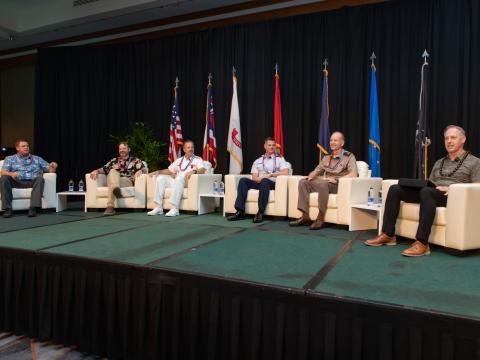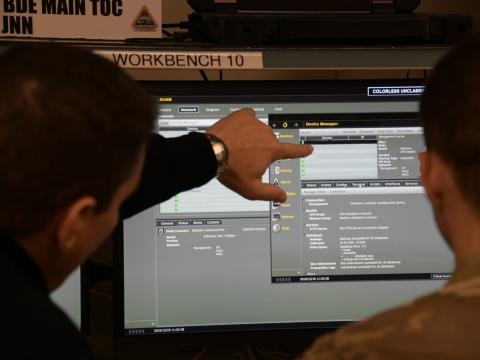Virtual Machine Technology Enhances Training for Marines
 |
| The command, control, communications, computers and intelligence (C4I) Mobile Application Server (CMAS) emulates a C4I network. CMAS allows users such as John Olson (c); Cpl. Andrew Reiplinger, USMC (l); and Cpl. Eric Holcomb, USMC, to hone their skills with one stand-alone package. |
U.S. Marines providing on-site command, control, communications, computers and intelligence support have a new tool—a tactical network in a box—that allows them to learn to use the most recent software in a virtual environment.
Since the September 11, 2001, attacks, individuals often have been compelled to use complex tactical network and application systems with little or no opportunity to practice before deploying. Brief instruction is forgotten quickly if skills are not maintained using operational equipment, and often, operating this equipment is neither possible nor practical. The Defense Science Board Task Force’s Training Superiority and Training Surprise Final Report 2001 states that because of organizational turbulence and the inability to train deploying units at centralized facilities efficiently, a critical need exists to take training to the units.
The command, control, communications, computers and intelligence (C4I) Mobile Application Server (CMAS) addresses this need by using a mobile learning capability separate from any government network. Marines in the field can perform tactical system tasks on practice virtual systems instead of on operational systems. This mobile server is a tool that, with computer-based training, can be shipped to units as part of periodic readiness training.
CMAS uses virtual machine technology that images real tactical systems to run as files on a physical computer. The advantages are many, including conservation of hardware resources because several virtual servers typically can operate on one physical server. Another benefit of virtual machine systems is rapid failover for mission-critical situations. In mobile tactical environments, benefits include reduced hardware and power consumption and increased data assurance. Reports have stated how the increasing complexity of computer code will drive future systems toward multiple virtual machines with distinct task performance. Using virtual machines in this manner serves to modularize mission-critical tasks into components that can be managed more easily.
A military laptop issued to the troops can be cloned into a virtual machine file and used for training. If desired, personnel can make copies of this imaged file, resulting in multiple virtual laptops. This allows the troops to practice on a tactical system using the same hardware and software found in the command center. An imaging system, the physical-to-virtual (P2V) tool from VMware Incorporated,
CMAS initially was developed to run multiple command and control PC (C2PC) desktops that receive real global command and control system tracks for practice sessions on a private network. VMware’s GSX server supplies the capability to operate virtual PC machines with tactical software and functional networking to connect to a real laptop global command and control system.
The global command and control system is the primary means the
CMAS hardware and software consist of a single server-level laptop using a Windows 2000 server operating system. The GSX server is loaded on the operating system server as an application. A critical hardware feature is random access memory (RAM) because the laptop resources are shared by the virtual machine PCs. One suitable laptop, available through the U.S. Marine Corps common hardware suite (MCCHS), is a semirugged system capable of 4 gigabytes of RAM. The GSX server runs on Windows 2000, Windows 2003, Windows XP and Linux operating systems.
Recently, VMware made the server versions available for free download to those who register as users. On a server-laptop, the operating system comes preconfigured as a built-in cost of the hardware. Linux is popular and can be free if open-source versions are used. It may have a place in CMAS in the future, but at this point in system development Windows is being used for simplicity.
CMAS setup takes less than 30 minutes, after unpacking the small transit case, to reach an operational state. The server-laptop must be turned on, followed by startup of all the virtual machine PCs. A network consists of a low-cost network switch and Ethernet cables. Trainees are each provided with an inexpensive laptop that is used only to network with the server-laptop and to run a VMware remote desktop application.
The remote desktop program on the client-laptop connects to the server-laptop. The individual virtual PC is assigned to the student. The server-laptop is equipped to handle four or more virtual PCs. This setup allows each user to click a tab to view the instructor machine for a demonstration. After instruction, each trainee returns to his or her virtual desktop to repeat the steps learned.
Virtual machines can run in one of several disk modes that either preserve or discard changes made by an operator. In persistent mode, any change made to the virtual PC is written to the disk file. Nonpersistent mode allows a student to make changes and mistakes and to install or remove software. When the virtual PC is turned off, the disk file returns to its baseline state. The fastest performance for the user is obtained by using the persistent mode, in which keeping track of changes is not necessary. The nonpersistent mode is excellent for testing new software loading and experimenting to make software operate. Running several virtual machines in nonpersistent mode requires keeping a log of changes for each of the virtual machines. This is taxing on the server-laptop resources shared among the operating systems. CMAS uses persistent mode for student sessions, which improves the user experience. When finished, the virtual machine file is overwritten by a master copy.
Hardware that interfaces with the physical computer is available to the virtual PC. If the host server has a universal serial bus (USB) port, the port can be accessed by the virtual PC. Loading software to practice configuring settings can be accomplished by inserting a CD in the server-laptop drive bay. Students view the computer disk splash screen, see a menu of options and experience the other steps that occur during software installation.
Solutions are available for an organization with an older version or a different version of the software used by the Marines. Requirements for a different product can be resolved by starting a new virtual machine with the desired software. This different version can be kept on a portable external drive for transfer to the server-laptop.
The global command and control system does not run as a virtual machine, but a global system laptop is beneficial because operators must know how to connect C2PC to the global command and control system. Operators should understand where the data comes from and how the data is reduced to avoid system overload, and they should practice creating or managing real system tracks. Methods exist to place a reduced set of tracks on the practice network without a global command and control system, but that sacrifices the capability to mimic the real world.
CMAS can be used by deployed units to sharpen tactical situational awareness application skills. Skills can be further enhanced by the use of computer-based training modules in conjunction with actual applications. CMAS can run nuclear, biological and chemical monitoring software; communications planning programs; and other tactical networking applications. It supports system administrator as well as operator training for C2PC, the System Planning Engineering and Evaluation Device, new versions of operating systems, Microsoft Exchange and other uses. Loading and configuration procedures can be practiced and documented in a virtual environment prior to installation on critical systems. Operators can use new but unreleased versions of software in a benign training environment, gaining proficiency without risk to operational systems or networks.
The Marine Corps Tactical Systems Support Activity (MCTSSA),
MCTSSA teams took CMAS to
CMAS also was used for demonstrations and familiarization training on an upcoming version of C2PC for deployed forces.
In May 2006, a MCTSSA team traveled to
Allan D. Kissam is a computer engineer with the


Comments